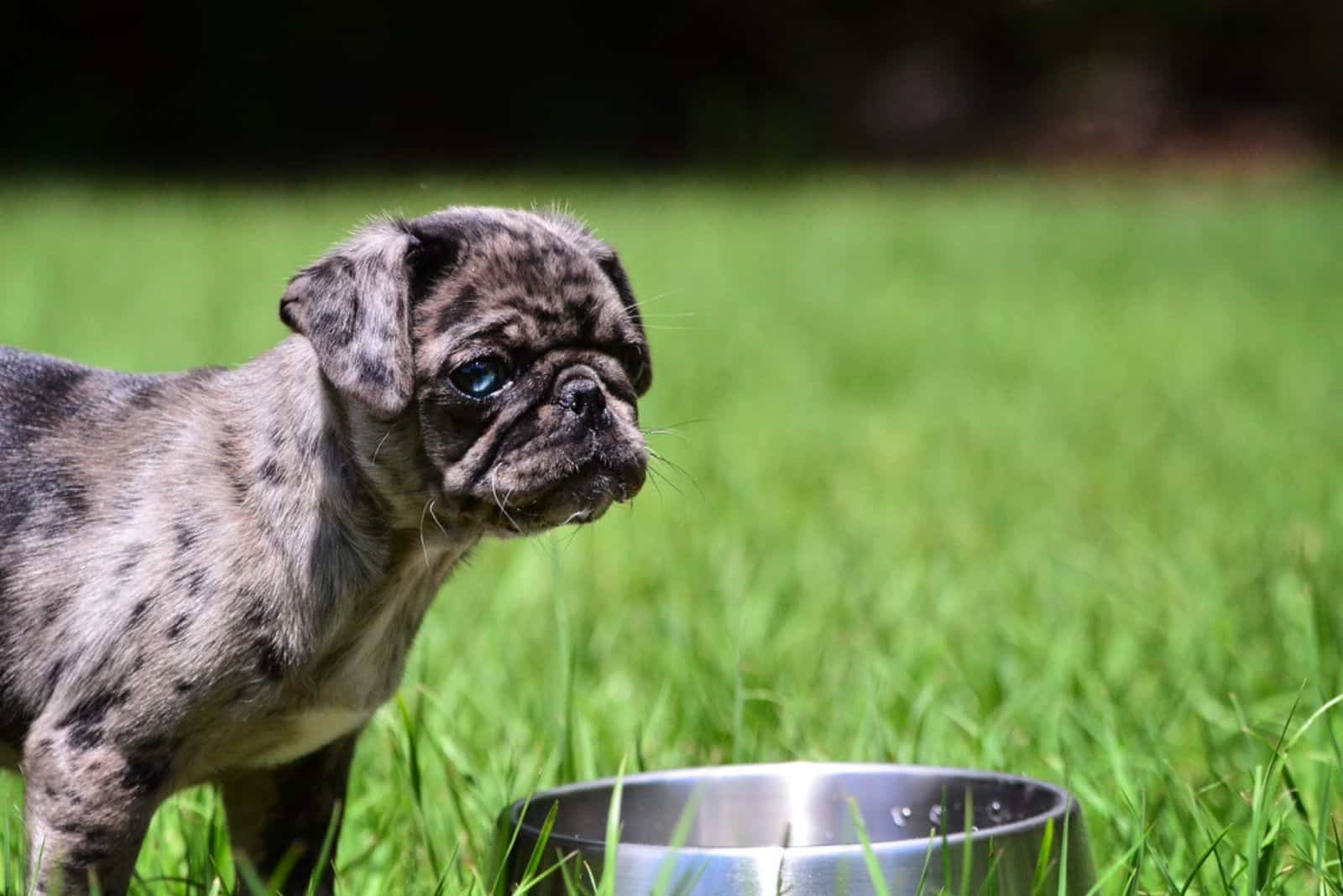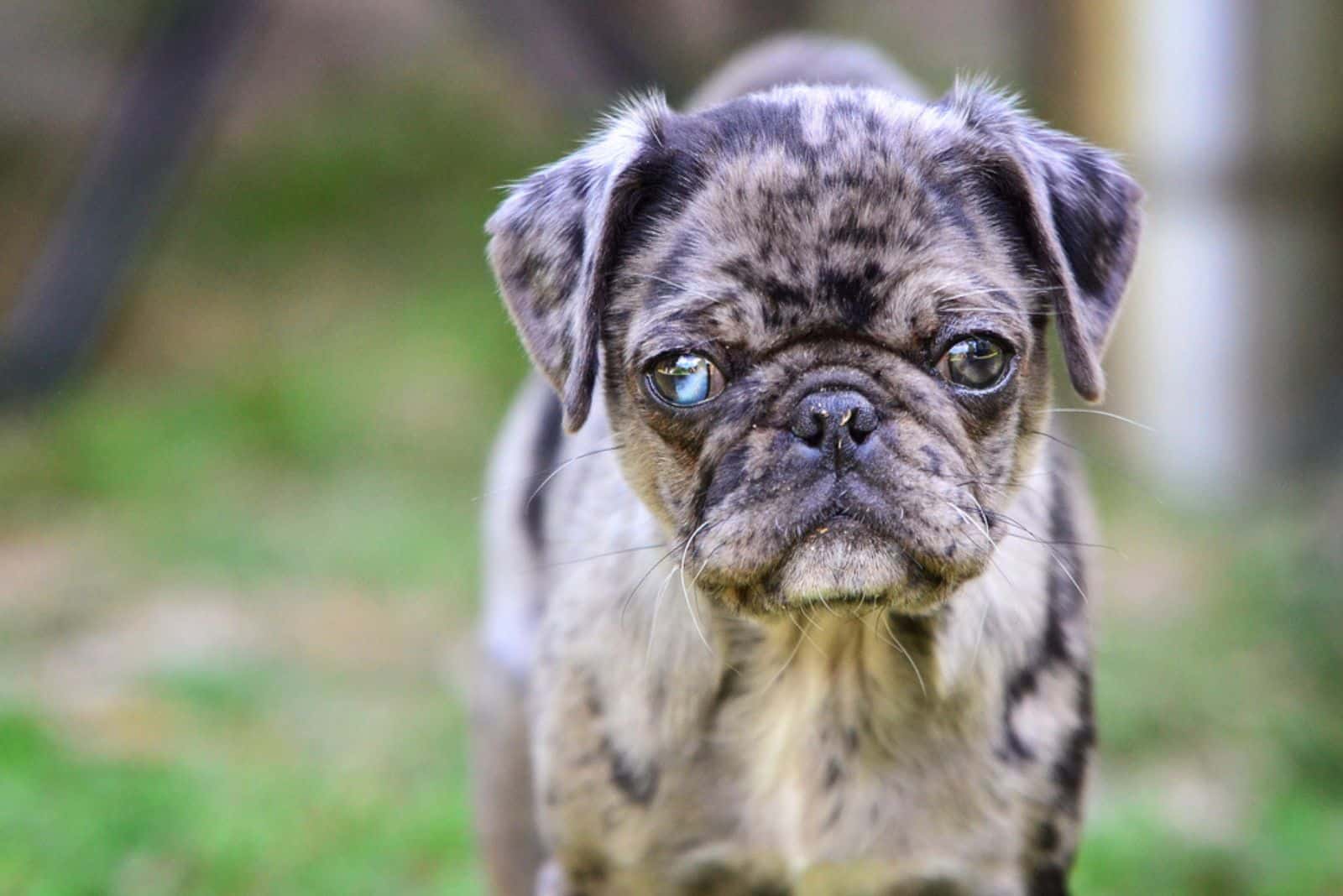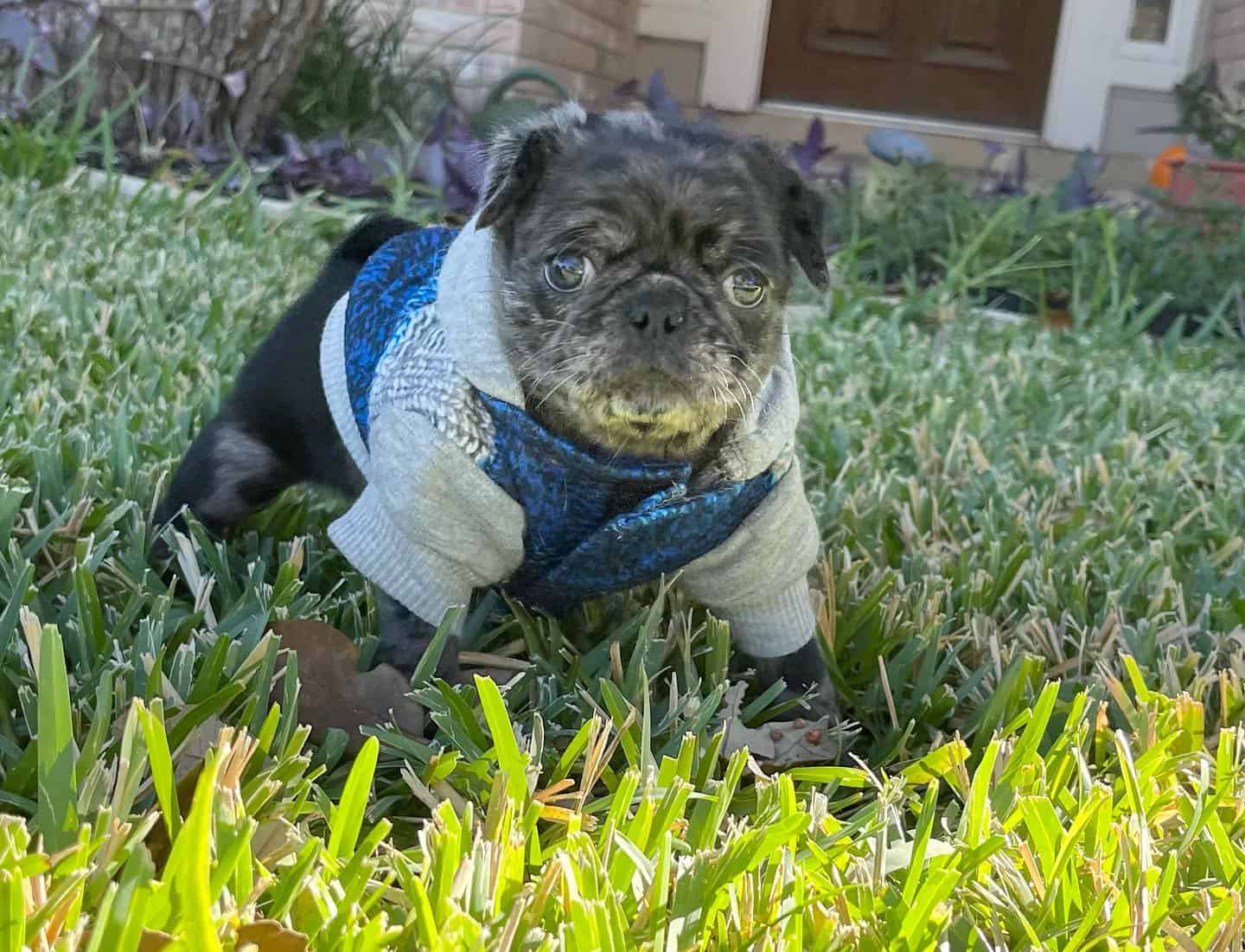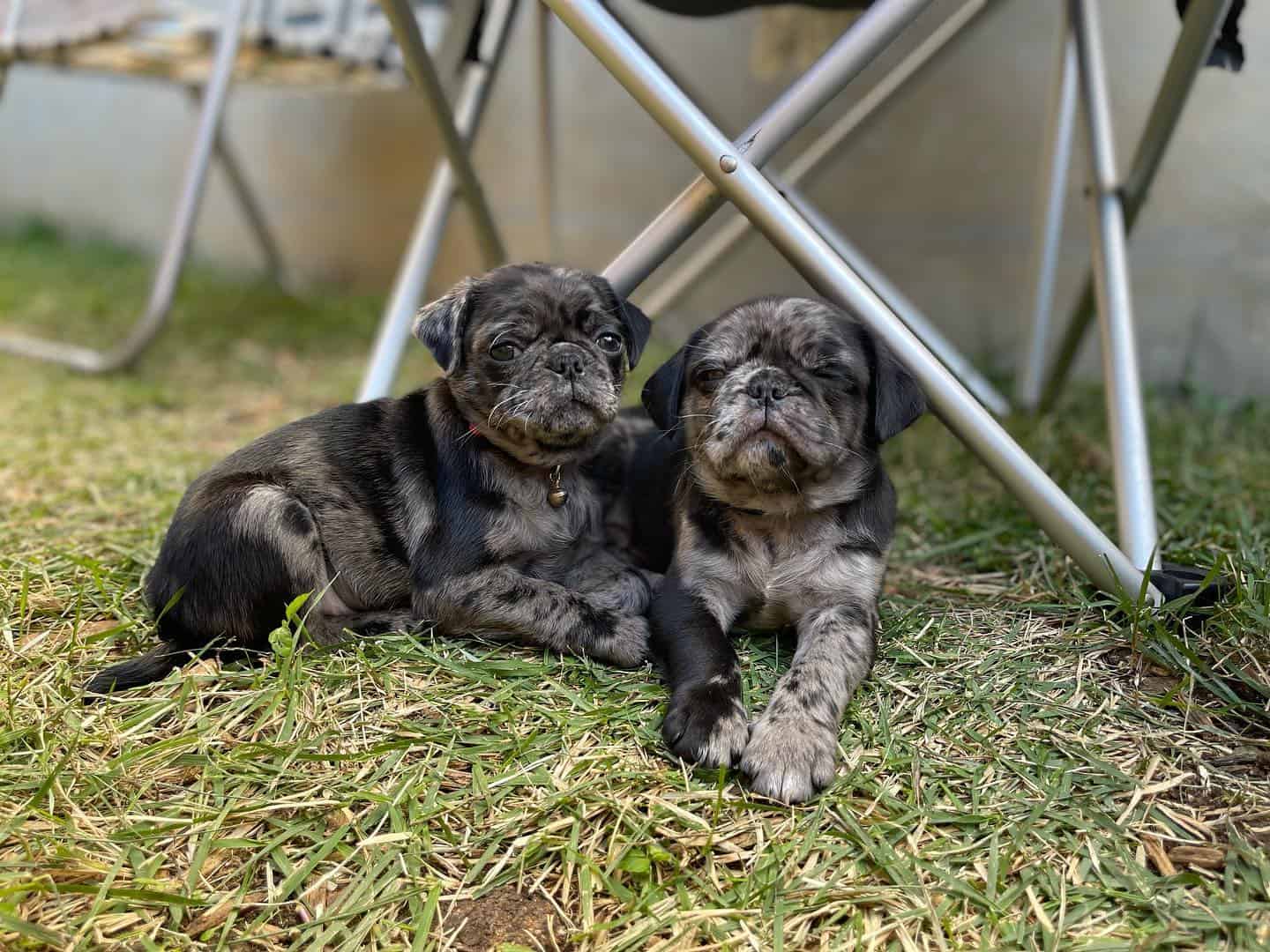The Pug breed has been with us for centuries. They’ve been beloved companions and excellent watchdogs for as long as people can remember. Originally from China, these dogs have come a long way with transformation and improvement, which has resulted in lots of coat colors, including merle.
Welcome! Today, we’ll discuss the merle Pug – a coat color that’s very beautiful, but carries so many hidden threats.
How can a coat color be dangerous?
Oh, trust me… it can!
The presence of the merle gene is a clear sign that your dog may suffer from certain genetic problems. Living with health issues as severe as blindness or cancer is something no dog owner wants for his dog.
If you’re thinking of getting a Pug, and you’ve come across a special merle Pug, think about your decision of getting it.
The kennel clubs that are leading in the world (the AKC and the UKC) are strictly against merle Pugs, and they will never accept them.
Don’t trust their decision? Well, you’re definitely going to trust what PupVine has to say about the merle Pug!
What Is A Merle Pug?

The merle Pug is just as much Pug as any other specimen of this breed. Merle puppies are still Pugs with the same body and temperament characteristics as fawn or black Pugs.
But, there is one huge difference between merle Pugs and the rest of the Pug colors, and it’s not visible. The issue with the merle coat is that it does not occur naturally with this dog breed. For example, Border Collies, Corgis, French Bulldogs, as well as merle Chihuahuas come naturally in merle.
The merle coat is a result of gene manipulation either by accident or on purpose.
If you’ve never seen a merle coat before, you should know that merle manifests as a shade of the coat covered in patches all over it. Those patches are often blue or gray, and appear a bit washed-up. You may recognize them as blue merle Pugs.
The base coat is not a solid color. It’s a combination of two colors, also known as piebald.
The merle gene is a strong one, and it appears not only on the dog’s coat, but also on its skin. For example, a puppy’s nose can be merled, too!
Although merle is simply a stunning coat pattern, it brings along many potential problems, and a wide list of hereditary genetic conditions.
We’ll discuss in depth the potential health problems of merle Pugs, and see whether you should or shouldn’t get one.
But now, let’s talk about that merle gene, and when the first merle Pugs appeared.
The Origin Of The Merle Pug

The merle coat color is not something you’ll find naturally with Pugs. We’ll discuss how to achieve this coat color soon.
Now, I want to discuss the origin of merle Pugs. When did they first appear? Do we know who the first merle pug was?
Unfortunately, we don’t know when the first merle Pugs appeared.
Pugs are an ancient breed. They were bred and improved throughout history so many times that it’s completely impossible to keep track. Today, Pugs are still very popular, and due to all this popularity, it’s highly regarded that the first merle Pugs were bred some time in the past, possibly several centuries ago.
It’s most likely that the first merle Pugs were a result of accidental breeding. However, that’s not the case today. These days, planned breeding is what breeders use in order to achieve the desired coat.
Merle Pugs are all the rage. They’re still very much in demand, and breeders have used that fact to create a small business around merle Pugs. And, let me tell you something – this business is booming!
About The Merle Color
The merle color is a result of specific genes. Canine experts call those genes M genes.
Remember when I told you that the merle coat pattern can occur naturally with some dog breeds, like Collies? Well, that’s still not the majority of dog breeds. It’s a really small number of dogs that can turn out to be merle naturally.
Pugs can’t be natural merles.
So, how does the merle gene occur with the Pug dog breed? Are those Pugs really purebred dogs?
The merle gene has to be introduced from another dog breed. Dogs that are carriers of the merle gene were probably used in the breeding process some time in the past, which has resulted in merle Pug puppies. This is a long process, and it does not guarantee success every time.
When you look at a merle Pug’s bloodline, in case they go that far back in the past, you may notice a little intruder… some merle pup that was crossed with a Pug. Also, merle Pugs can be crossed with other Pugs to achieve a spotted coat.
So, when a breeder tries to sell you a purebred merle Pug, don’t trust a word he’s saying. He either doesn’t know a thing about Pugs or doesn’t know how the genetics work, or he’s fully aware of it and is trying to scam you.
Transferring The Merle Gene

When it comes to the merle gene, we can tell apart two different merles: the big M and the little m. The entire merle coat depends on the combination of these merle genes.
Here’s a bit of canine genetics simplified for you:
The merle coat color may appear if the puppy inherits one copy of the M gene. The m gene from the other parent does not have to be present.
Also, two M genes are of a certain merle coat – sadly, a double merle.
You can avoid the merle coat if your puppy inherits two sets of the m gene and no M genes at all.
How Healthy Are Merle Pugs?
Pugs aren’t the healthiest dogs of them all. I’m sorry, but that’s a fact derived from their unusual body features.
Pugs are small dogs with thin legs, and yet, a sturdy body. Their physical appearance isn’t the greatest, but they seem to get along with it. The first thing that many dog owners notice about Pugs is their smushy face. That’s a clear sign that you have a brachycephalic dog – a breed with a flat nose and potential breathing issues.
All Pugs are prone to breathing problems of all kinds, especially BOAS. This condition stands for Brachycephalic Obstructive Airway Syndrome, and it affects the upper airways.
But, this is something that all Pugs experience. Are there conditions specifically linked to merle Pugs only?
Merle Pug Health Issues

Before we talk about those issues, you need to understand something: just because your Pug is merle doesn’t mean he’ll definitely suffer from some sort of a health problem. There’s still a chance your merle will be a healthy Pug.
Still, there’s a high risk, and you should be aware of it.
One of the biggest potential health issues for merle Pugs is deafness. Hearing problems can affect one or both ears. They can vary in intensity from partial deafness to complete loss of hearing.
Hand in hand with deafness comes blindness. The same rules apply to blindness: one or both eyes, and partial or complete blindness.
These are conditions that your merle Pug can live with. Sure, it’s tough, but at least they’re alive and not in pain.
However, there’s another major health problem that strikes merle Pugs. It’s a skin problem.
Pugs are known for having many skin hot spots. Their coat is super short and sleek, wrinkly, and prone to infections. Because of the lack of melanin in the spotted areas, merle Pugs are highly prone to hypersensitivity to sunlight. Merle Pugs can easily get sunburns, which can, unfortunately, lead to skin cancer.
Applying sunscreen on your merle Pug is not ridiculous. I encourage you to do so every time you go out in the sun, when the UV index is super high.
Along with other common Pug health problems like BOAS, obesity, Pug dog encephalitis, Legg-Calvé-Perthes disease, etc., the mentioned congenital health issues may have terrible outcomes for your merle Pug.
What’s A Double Merle Pug?
When we talked about breeding merle Pugs to non-merle Pugs (or standard Pugs) earlier, we mentioned that those dogs may or may not turn merle. There’s about a 50% chance that merle puppies will come from such parents.
You can assume what you’re supposed to do in order to be sure your pups will end up as merle Pugs.
You’ll need to breed two merle Pugs!
When breeding two Pugs that are merle, you increase the chance that the puppies will be merle, too. There’s almost a 100% chance those little ones will carry the same merle gene as their parents.
Breeding of two merles results in puppies that are known as double merles.
While double means certainty that the pup will have the gorgeous merle coat, it also means there’s even more of a chance that the puppy will end up being ill.
Double merle Pugs are almost always ill. Rarely does any double merle puppy end up being happy and healthy. Double merles are born with severe vision impairment, some are even missing their eyes altogether!
I would never recommend getting a double merle Pug puppy. Breeding and supporting double merles is unethical no matter if it’s a Pug or any other dog breed. They’re shoulder to shoulder with teacup Pugs – another result of unethical practices.
How Rare Are Merle Pugs?

Merle Pugs are super rare, but they’re not the rarest of all Pug colors. Of all the Pug colors including apricot, black, silver, and fawn, the non-recognized color is the rarest. That’s the brindle Pug. The American Kennel Club (AKC) approves of only the four mentioned colors.
As I mentioned earlier, it takes a lot of effort, time, and dedication to get a merle dog. And, for what? For having a Pug that may or may not be severely ill? No, thank you!
PupVine promotes health over physical appearance any time. So, if you’re looking for good Pug breeders, this is the list you need to check out.
Merle Pugs are difficult to breed because there’s always a chance that the puppies won’t end up being merle. One merle parent isn’t enough to be sure that the litter will have the same markings.
However, if you breed both merle parents, you get an even bigger problem, and that’s the double merle Pug we discussed just above.
Good luck finding a merle Pug whose owner is ready to breed him or her.
Are Merle Pugs Expensive?
Well, this is a surprise!
Merle Pugs are usually more pricey than other Pug colors. I find it hard to believe why someone would price potentially ill puppies higher than perfectly sound dogs of standard colors. The only reason I can see such an approach is profit, and profit only.
Since merle Pugs have a super rare color, some breeders have taken the advantage of it and decided it’s a good idea to promote merles as something desirable, rare, and exotic. Adding the adjective exotic always plumps up the price of the puppy, and makes people want it more.
Unfortunately, many potential dog owners aren’t aware of the dangers of the merle gene. Many of them don’t even realize that what’s beautiful on the outside isn’t beautiful inside. They don’t mind paying an extra penny to have a special, one of a kind, unique dog in the park.
In fact, such people are very proud of having merle Pugs because they believe all the other dog owners envy them. But, as we know, beauty isn’t everything.
Being proud of the merle coat is a bit ridiculous.
Still, breeder’s seem not to care about the ethics of dog breeding, and list merle Pugs for $3,000 and even more! That’s more than the standard Pug’s cost.
The bottom line is: don’t waste your money.
Should You Get A Merle Pug?
I’m sorry that I don’t have a pawsitive answer to this question.
Personally, I believe you shouldn’t get a merle Pug.
Every dog owner wants a healthy puppy to spend lots of happy years with. No matter how well you take care of your merle Pug puppy, take him to regular vet checkups, or buy him the best food possible – you can’t change the fact that he’s a merle.
The merle coat carries numerous health threats, and you never know when one of them will mess up your Pug’s wellbeing.
So, to sum up everything: please avoid the merle Pug and pick any other approved Pug color.
They’re all lovely, aren’t they?
Read More: 14 Reasons Why Pugs Are The Worst















